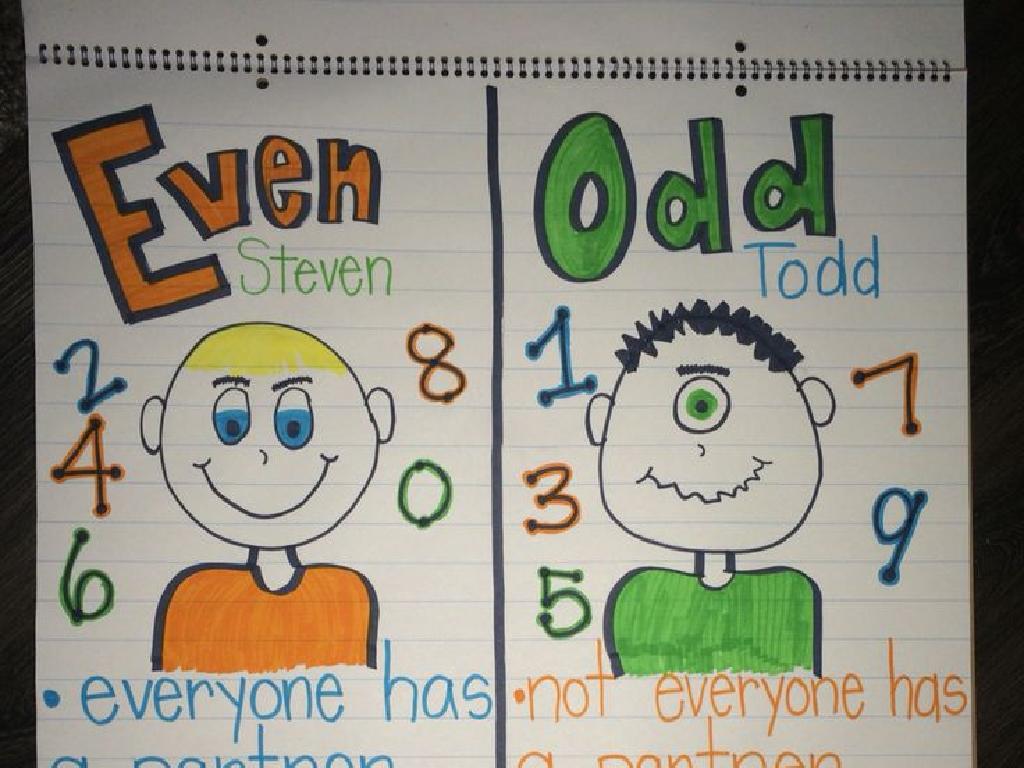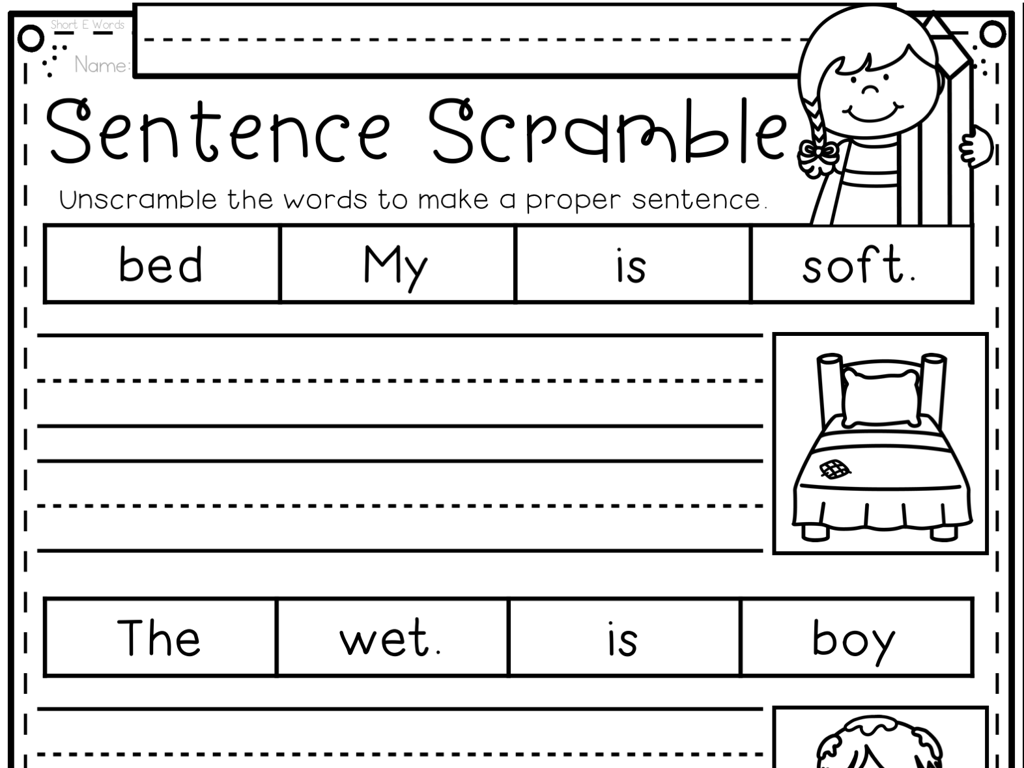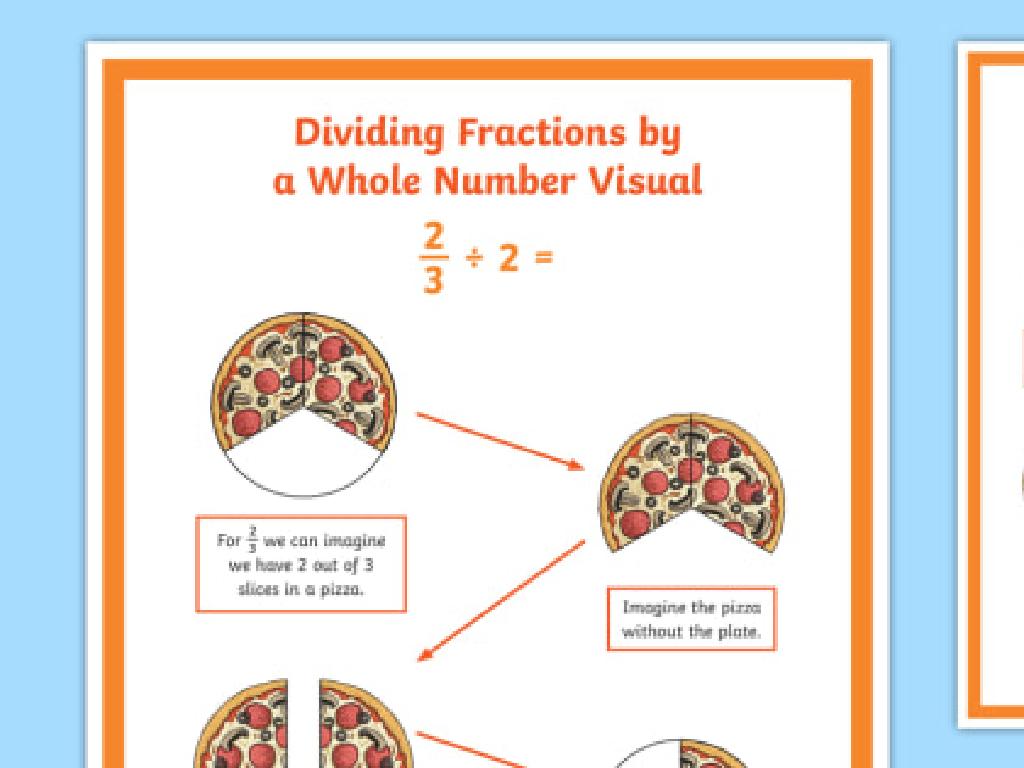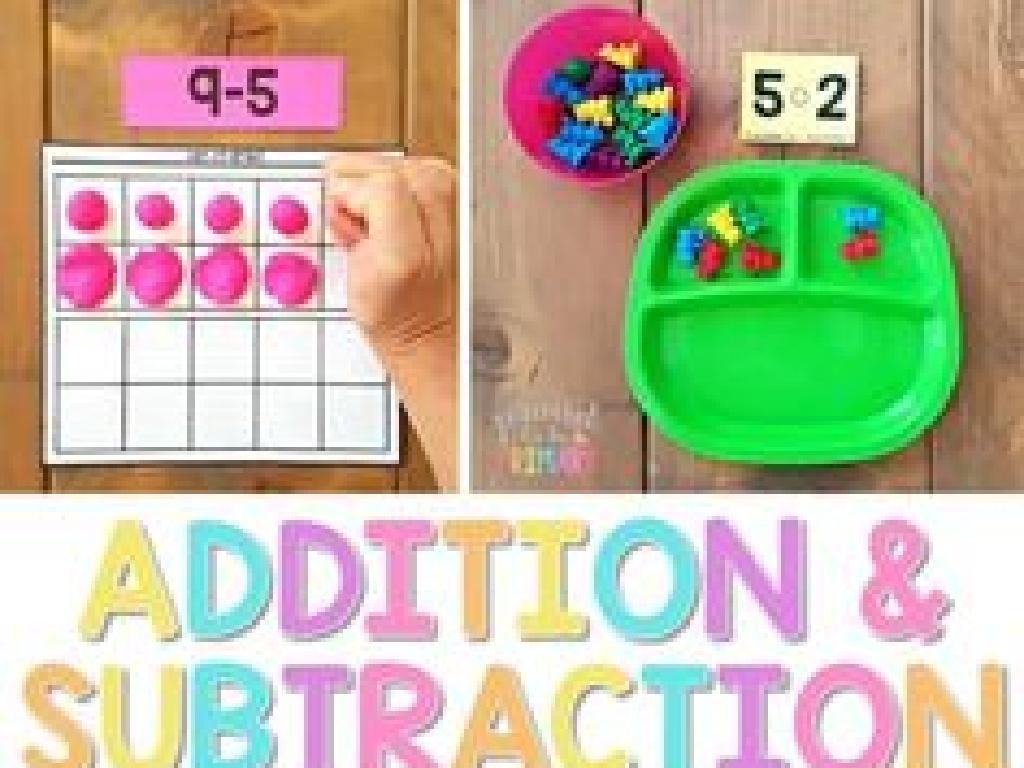Find The Total Given A Part And A Percent
Subject: Math
Grade: Sixth grade
Topic: Percents Of Numbers
Please LOG IN to download the presentation. Access is available to registered users only.
View More Content
Welcome to Percents!: Finding Totals
– Percents in daily life
– Discounts, tips, and interest rates involve percents
– Quick review: What is a percent?
– A percent represents a part out of 100
– Today’s goal: Find the total
– Use the formula: Total = Part / (Percent / 100)
– Solving real-world problems
– Apply formula to calculate total cost, savings, etc.
|
This slide introduces students to the concept of percents and their practical applications in everyday life, such as calculating discounts, tips, and interest rates. Begin with a quick review of what a percent is, emphasizing its representation as a part of 100. The main objective of today’s lesson is to teach students how to find the total when given a part and its corresponding percent. Demonstrate this with the formula Total = Part / (Percent / 100), and provide examples such as finding out the total cost of an item after applying a discount or calculating the total savings from a given interest rate. Encourage students to think of other scenarios where this knowledge is applicable.
Understanding Percents
– Percent means ‘per hundred’
– Used to compare different quantities
– Convertible to fractions
– Example: 50% as a fraction is 50/100, which simplifies to 1/2
– Convertible to decimals
– Example: 25% as a decimal is 0.25
|
This slide is a review of the basic concept of percent, which is a crucial foundation for understanding how to find the total given a part and a percent. Emphasize that ‘percent’ means ‘per hundred,’ which is a way of expressing a number as a fraction of 100. This is useful for comparing quantities in different scenarios, such as test scores, discounts, and population statistics. Show students how to convert percentages to fractions by placing the percent over 100 and simplifying if possible. Also, demonstrate converting percentages to decimals by dividing by 100 or simply moving the decimal point two places to the left. Provide additional examples and practice problems to reinforce these concepts.
Understanding Parts and Percents
– ‘Part’ is a portion of ‘Total’
– ‘Percent’ defines the part’s value
– Example: 25% of 100
– 25% means 25 out of every 100, so 25% of 100 is 25
– Finding the total from part and percent
– If 25 is 25% of a number, the total is 100
|
This slide introduces the concept of parts and percents in the context of mathematics. The ‘Part’ refers to a specific portion of a whole, which we call the ‘Total.’ The ‘Percent’ is a way to express how large the part is relative to the total, as a fraction of 100. For example, if we know that 25% of a certain number is 25, we understand that this percentage represents 25 out of every 100 units of that number, making the total 100. The goal is to help students grasp how to find the total when given a part and its corresponding percent. Encourage students to think of percents as parts of 100 and to use this understanding to solve problems involving finding totals from given parts and percents.
Understanding the Percent Equation
– The Percent Equation basics
– Part equals Percent times Total divided by 100
– Calculating the Total from Part and Percent
– To find Total, divide Part by Percent over 100
– Breaking down the equation step-by-step
– Practice with real examples
– Example: If 30% of a number is 12, what is the number?
|
This slide introduces the Percent Equation, a fundamental concept in understanding percentages. Start by explaining the basic form of the equation, where ‘Part’ represents the portion of the total amount, ‘Percent’ is the percentage, and ‘Total’ is the full amount. Show how to rearrange the equation to solve for ‘Total’ when given ‘Part’ and ‘Percent’. Walk through the equation step-by-step, ensuring students understand each part of the process. Finally, provide real-world examples for students to apply the equation, such as finding the total price of an item after knowing the sale price and the discount percentage. Encourage students to solve these problems and share their solutions. This will help solidify their understanding of how to work with percentages in practical situations.
Finding the Total from a Percent
– Understand the percent equation
– Example: 30% of a number is 45
– If 30% equals 45, what’s the whole number?
– Set up the equation
– Use the formula: Part = (Percent x Total) / 100
– Solve for the Total
– Rearrange to find Total: Total = Part / (Percent / 100)
|
This slide is aimed at teaching students how to find the total when given a part and its corresponding percent. Start by explaining the basic percent equation and how each term relates to the problem at hand. Use the example provided to illustrate the process: if 30% of a number is 45, we need to find the total number. Show students how to set up the equation using the formula Part = (Percent x Total) / 100, and then how to solve for the Total by rearranging the equation to Total = Part / (Percent / 100). Work through the example step by step, ensuring to check for understanding at each stage. Encourage students to practice with different percentages and parts to solidify their understanding.
Finding the Total from a Percentage
– Understand the problem: 20% of a number is 60
– Apply the percent equation
– Use the formula: Part = Percent x Total
– Discuss each step to solve
– Step 1: Convert percent to decimal (0.20), Step 2: Divide the part by decimal (60 ÷ 0.20)
– Review the solution together
– Total = 300, verify by calculating 20% of 300
|
This slide is aimed at practicing the concept of finding the total when given a part and its corresponding percent. Start by ensuring students understand the problem statement. Introduce the percent equation and guide them through converting the percentage to a decimal. Then, demonstrate how to rearrange the equation to solve for the total. Discuss each step clearly and solve the problem as a class. Once the total is found, verify the solution by calculating 20% of the total to ensure it equals the given part. Encourage students to ask questions and try similar problems for better understanding.
Group Activity: Finding the Total
– Break into small groups
– Receive unique ‘part and percent’ problems
– Each group gets a distinct set of problems to solve
– Calculate the Total for each problem
– Use the formula Total = Part / (Percent / 100)
– Discuss methods and answers
– Share strategies with the class after solving
|
This group activity is designed to foster collaborative learning as students work together to solve ‘part and percent’ problems. Divide the class into small groups, ensuring a mix of abilities in each. Provide each group with a unique set of problems that require them to find the total when given a part and its corresponding percent. Encourage students to use the formula Total = Part / (Percent / 100) to find their answers. After the activity, have a discussion where each group explains the method they used and the answers they found. This will help students learn from each other and understand different approaches to the same problem. Possible activities could include real-life scenarios such as shopping discounts, tax calculations, or statistics in sports.
Class Discussion: Understanding Percents
– Groups present their solutions
– Discuss various solution methods
– Compare different strategies used by groups
– Address any misconceptions
– Teachers corrects any errors in reasoning
– Reinforce correct understanding
– Highlight the importance of finding the whole from a part and a percent
|
This slide is meant to facilitate a class discussion where students will share the solutions they’ve worked on in groups. It’s an opportunity for them to explain their thought processes and the methods they used to find the total when given a part and a percent. During the discussion, pay attention to the different strategies students used and highlight the benefits of various approaches. Address any misunderstandings or errors that come up, ensuring that all students leave with a clear and correct understanding of how to work with percents. Encourage students to ask questions and engage with each other’s explanations. As a teacher, provide guidance and clarification as needed, and reinforce the mathematical concepts behind finding the total from a given part and percent.
Individual Practice: Finding the Total
– Work on practice problems individually
– Use the equation: Total = Part / Percent
– If you have 30% of a number which is 15, how do you find the whole?
– Solve to find the Total value
– Apply the equation to different scenarios
– Be ready to discuss your solutions
|
This slide is aimed at reinforcing the students’ understanding of how to find the total when given a part and its corresponding percent. Provide a set of problems that vary in difficulty to cater to the diverse skill levels within the class. Encourage students to use the equation Total = Part / Percent, where ‘Percent’ is expressed as a decimal (e.g., 30% becomes 0.30). This will help them to isolate the ‘Total’ by performing the division. After completing the problems, students should be prepared to share their answers and explain the process they used to arrive at them. This will foster a collaborative learning environment where students can learn from each other’s approaches and mistakes. As a teacher, be ready to facilitate the discussion and clarify any misconceptions that may arise.
Review: Finding the Total from a Percent
– Recap steps to find the total
– Remember to divide the percentage by 100, then divide the part by this decimal.
– Importance of understanding percents
– Percents are everywhere! From sales tax to statistics in sports.
– Homework: Practice problems
– Solve problems to reinforce today’s lesson.
– Be ready to discuss solutions
|
As we wrap up today’s lesson, let’s review the steps to find the total when given a part and a percent. This is a crucial skill in math that applies to real-world scenarios like calculating discounts, interest rates, and more. For homework, students will complete practice problems to ensure they understand the concept. Encourage them to try different types of problems to challenge themselves. In the next class, we’ll discuss the solutions and address any difficulties encountered. This will help solidify their understanding and prepare them for more complex percentage calculations in the future.






